I’ll never forget my first job hauling fuel.
The trailer looked massive. Complicated. I didn’t even know what to call half the parts.
I was helping a construction client move diesel to a remote site, and all I could think was—is the right kind of trailer?
Since then, I’ve worked with dozens of logistics companies, drivers, and businesses that transport liquids every day. I’ve learned the ins and outs of tanker trailers—their uses, designs, and mistakes to avoid.
So if you’re trying to figure out what a tanker trailer really is and whether it fits your job, you’re in the right place.
In this article, I’ll explain it clearly. You’ll learn what tanker trailers carry, how they’re built, and who they work best for.
By the end, you’ll have what you need to make a smart decision—for your business or your next haul.
So let’s get started!
1. What Is a Tanker Trailer?
I was on a job site helping with a fuel delivery when a trailer caught my eye. It had no crates, no doors—just a smooth, shiny tank. Curious, I asked the driver what it was. He said, “That’s a tanker trailer. It’s built for hauling liquids.” I hadn’t thought much about trailer types before, but as I watched it unload through valves instead of forklifts, it clicked—every load needs the right trailer.
Tanker trailers are made for hauling bulk materials like fuel, milk, chemicals, or dry powders. They don’t need pallets or boxes. They use sealed tanks, valves, and pressure systems to load and unload safely. At Rhinotrail, we build custom tanker trailers to match your load—food-grade interiors, multi-compartment setups, or corrosion-resistant materials. Whatever you haul, we’ll build it to handle it.
Here are a few common examples:
- Fuels like gasoline, diesel, or jet fuel
- Food-grade liquids such as milk, edible oils, and juice concentrates
- Chemicals including acids and industrial solvents
- Gases like LPG (liquefied petroleum gas) and LNG (liquefied natural gas)
- Dry bulk materials such as cement, flour, or powdered chemicals
Each of these products requires careful handling. Some are flammable. Others need temperature control. Some even need pressure to stay in liquid form.
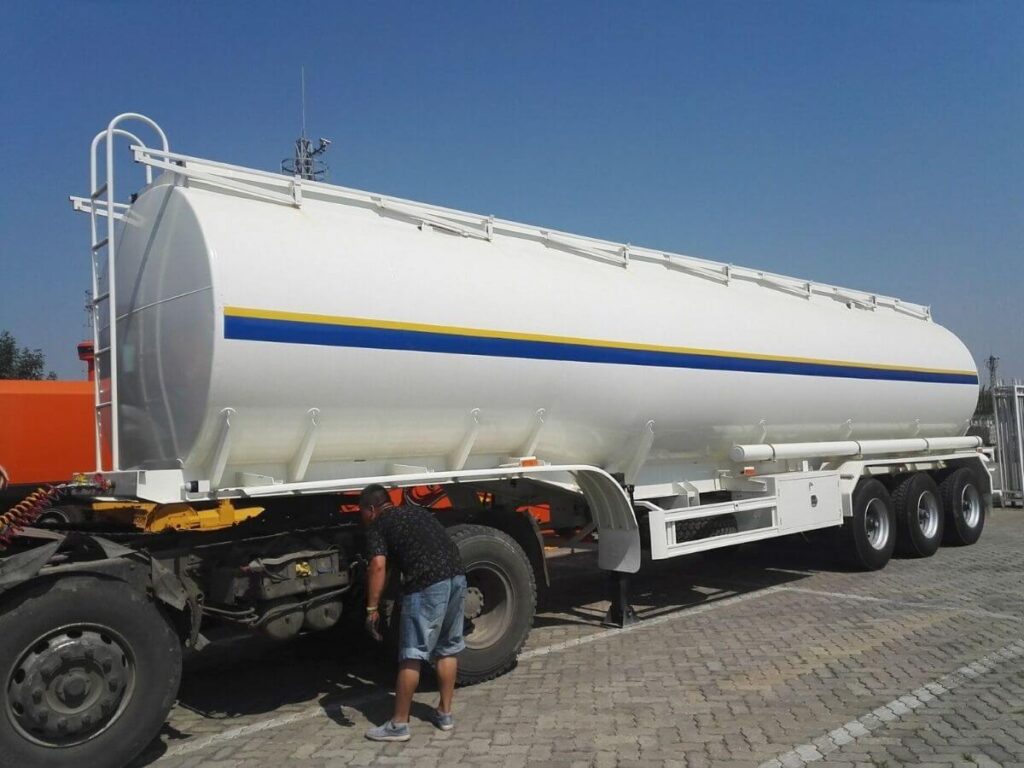
2. Pros and Cons of Using Tanker Trailers
Tanker trailers can be a great tool—if they fit your job.
I’ve seen them used in fuel delivery, milk transport, and even in mining operations. They’re powerful, but like any trailer, they come with pros and cons.
Pros
- Efficient for Moving Large Volumes: Tanker trailers are built to carry a lot—especially when it comes to liquids or gases. Instead of loading small containers one by one, you fill the entire tank in one go. That saves time and cuts down on labor.
- Lower Risk of Contamination: Since the tank is sealed, your cargo stays protected. This is important if you’re hauling food-grade materials like milk or oil, or hazardous chemicals that need safe transport. There’s less contact with air, people, and equipment.
- Multi-Compartment Options: Some tanker trailers have dividers inside the tank. That means you can carry different liquids on the same trip without mixing them. It’s helpful for companies delivering multiple fuel types or food products at once.
- Made for Specific Needs: You can get trailers with chemical-resistant coatings, insulated walls, or sanitary designs for food. These are built for safety and meet industry rules, whether you’re moving gasoline or orange juice.
Cons
- More Maintenance: Cleaning a tanker trailer is not quick or cheap. You often need special cleaning stations or certified washouts—especially for food or chemical loads.
- Limited Cargo Types: These trailers aren’t for everything. You can’t haul pallets, boxes, or heavy equipment. They’re made for bulk liquids, gases, or powders, and that’s it.
- Skilled Handling Needed: Loading and unloading a tanker isn’t as simple as opening a door. You’ll need trained operators who understand pressure systems, valves, and safety steps. Mistakes here can be dangerous.
- Higher Upfront Cost: Compared to general-use trailers like flatbeds or dry vans, tanker trailers cost more to buy. They also may require special permits depending on what you’re hauling.
3. Main Types of Tanker Trailers
Tanker trailers may look similar from the outside, but inside, they’re built very differently depending on the job. Each type is designed to carry a specific kind of material, whether it’s fuel, chemicals, food, or powder.
I’ve worked with haulers across fuel, food, and mining sectors, and I’ve seen how choosing the right tanker can make or break a job. To help you figure out which one fits your needs, here’s a closer look at the main types of tanker trailers.
Fuel Tanker Trailer
Fuel tankers are often made from aluminum to reduce weight and increase load capacity. They’re used to carry gasoline, diesel, and jet fuel for the oil and gas industry. Because they transport flammable liquids, they must meet strict safety standards—like DOT in the U.S. or ADR in Europe—including pressure valves, emergency shutoffs, and fire protection systems.
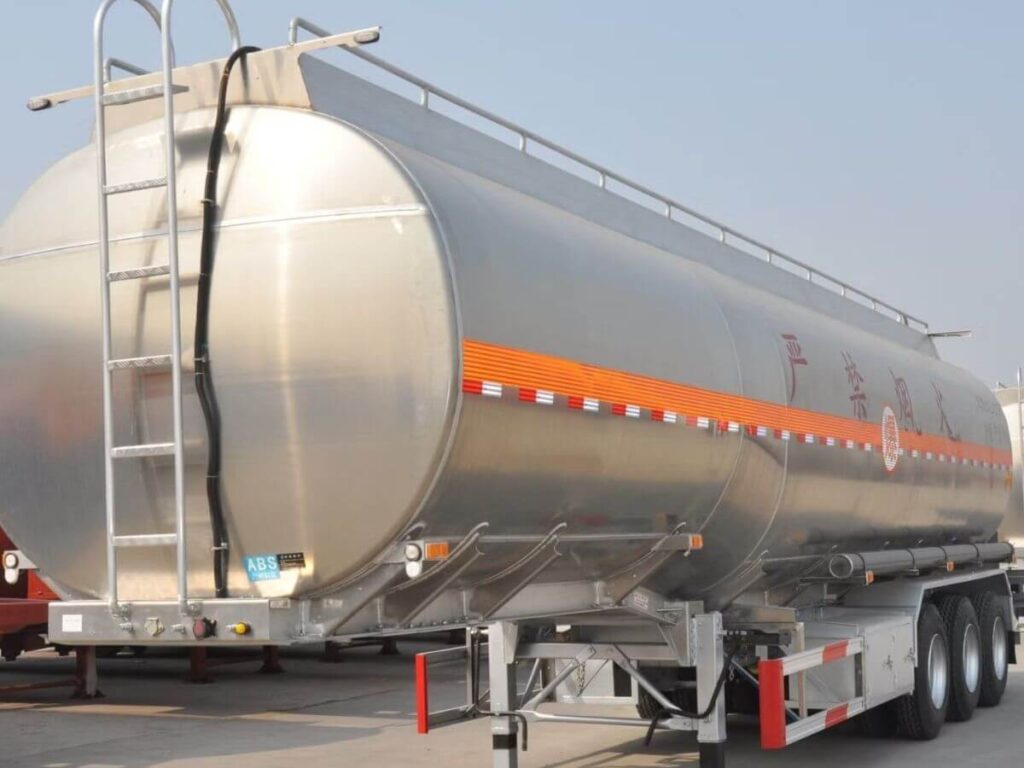
Chemical Tanker Trailer
If you’re in the mining or industrial sector, you’ll probably need a chemical tanker. These are made from stainless steel, which is strong and resistant to corrosion. That’s important when hauling acids, solvents, or industrial chemicals. Some chemical tankers even have interior linings to match the chemical being transported. It’s all about keeping the load stable and the trailer safe during transport.
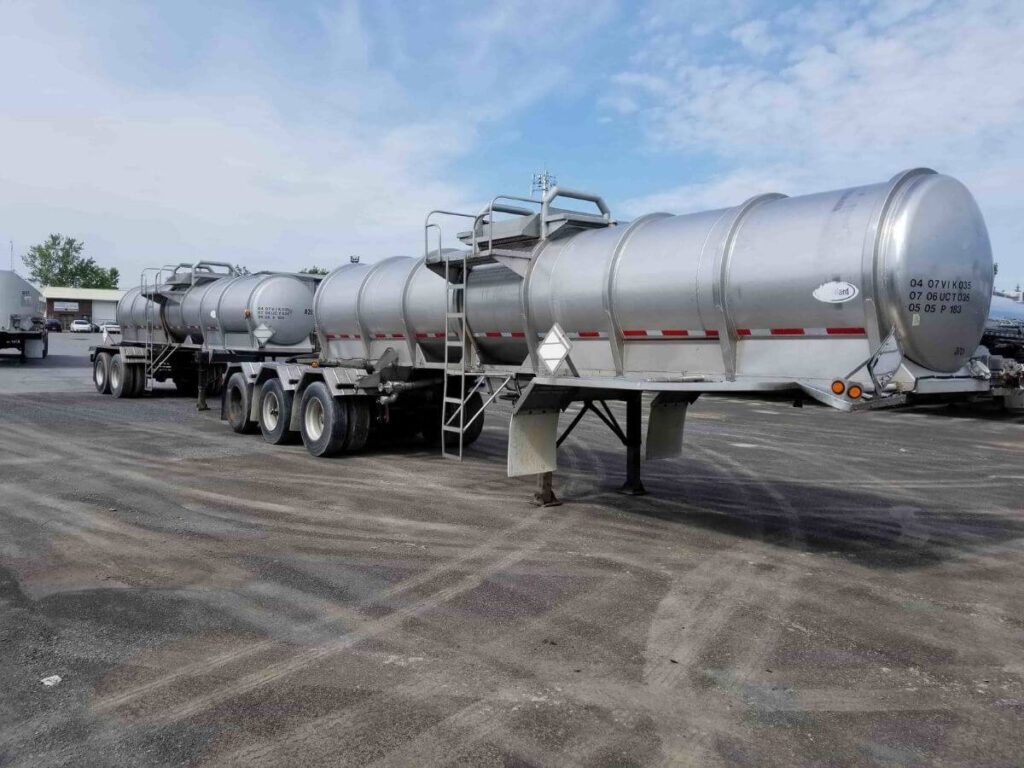
Food-Grade Tanker Trailer
Food-grade tankers are designed with hygiene in mind. They’re used for milk, edible oils, juice, and other liquid foods. The inside of the trailer is smooth and polished, which makes it easier to clean and prevents bacteria from building up. If you’re working in agriculture or food delivery, this is the kind of trailer you’ll likely be dealing with.
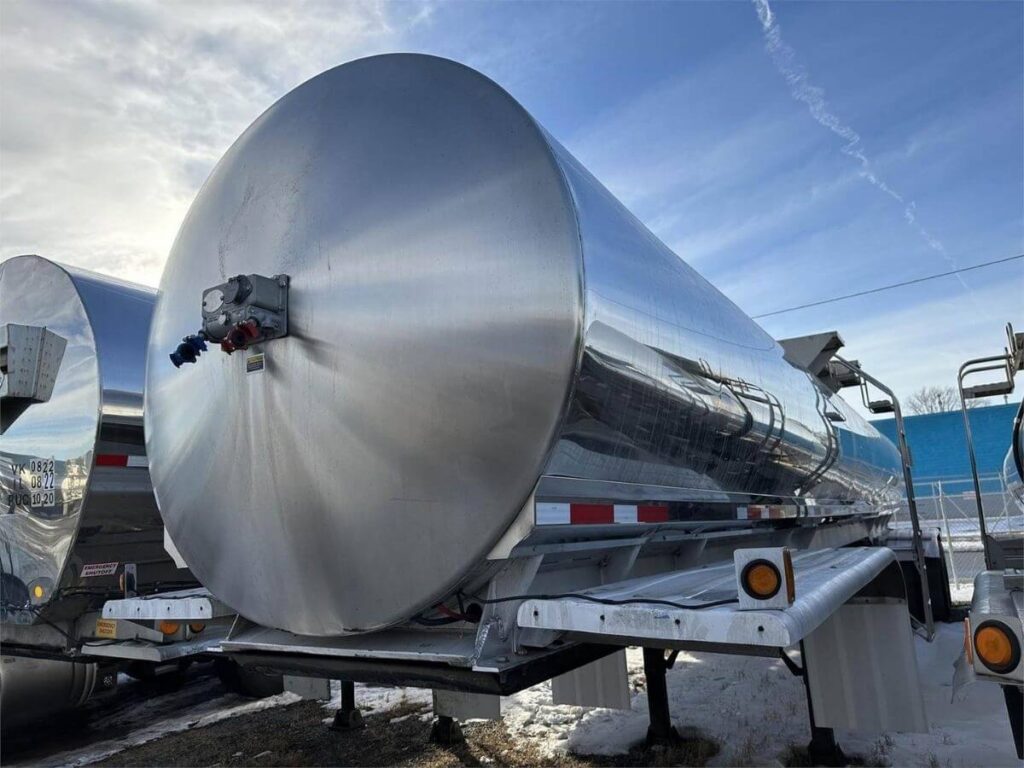
Dry Bulk Tanker Trailer
Unlike liquid tankers, dry bulk trailers are built for powdered or granular materials like cement, flour, grain, or animal feed. They usually have a V-shape or cylindrical body, and they unload either by tipping or by using air pressure systems. These trailers are ideal for high-volume dry materials that need to stay clean and dry during transport.
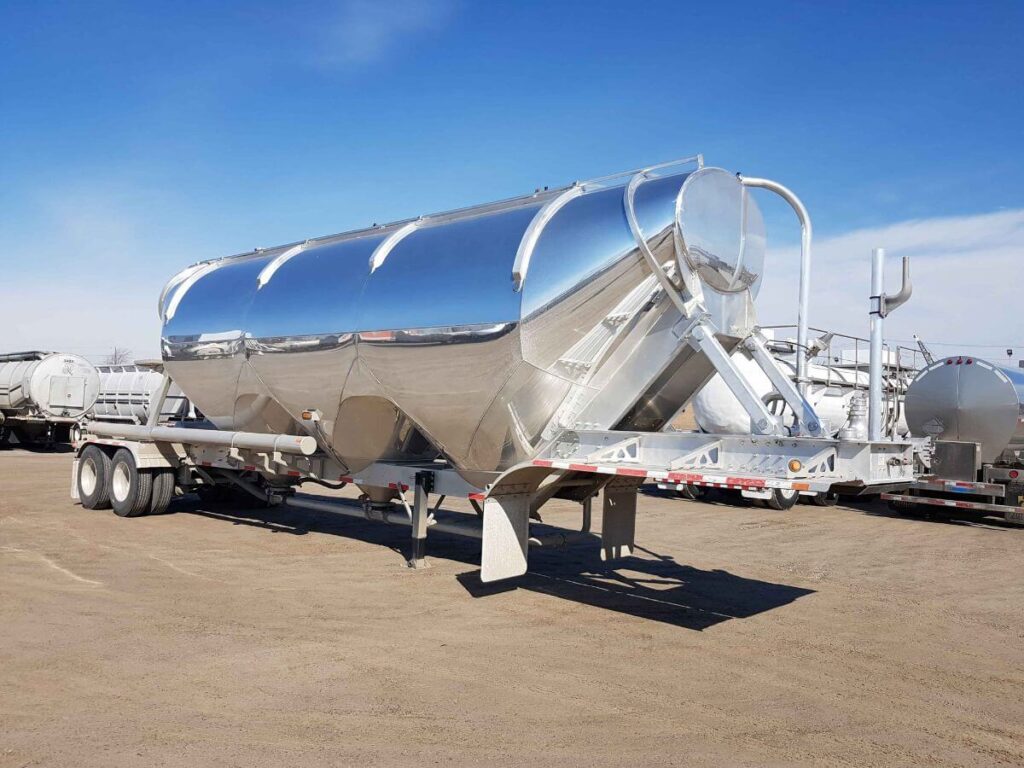
Gas Tanker Trailer
Gas tankers are made for pressure and safety. These are the trailers you see transporting LPG (liquefied petroleum gas) or LNG (liquefied natural gas). They have reinforced steel construction and often include insulation to keep gases cold and stable. If you’re in the energy or fuel business, a gas tanker is usually required by law for safe transport of compressed or liquefied gases.
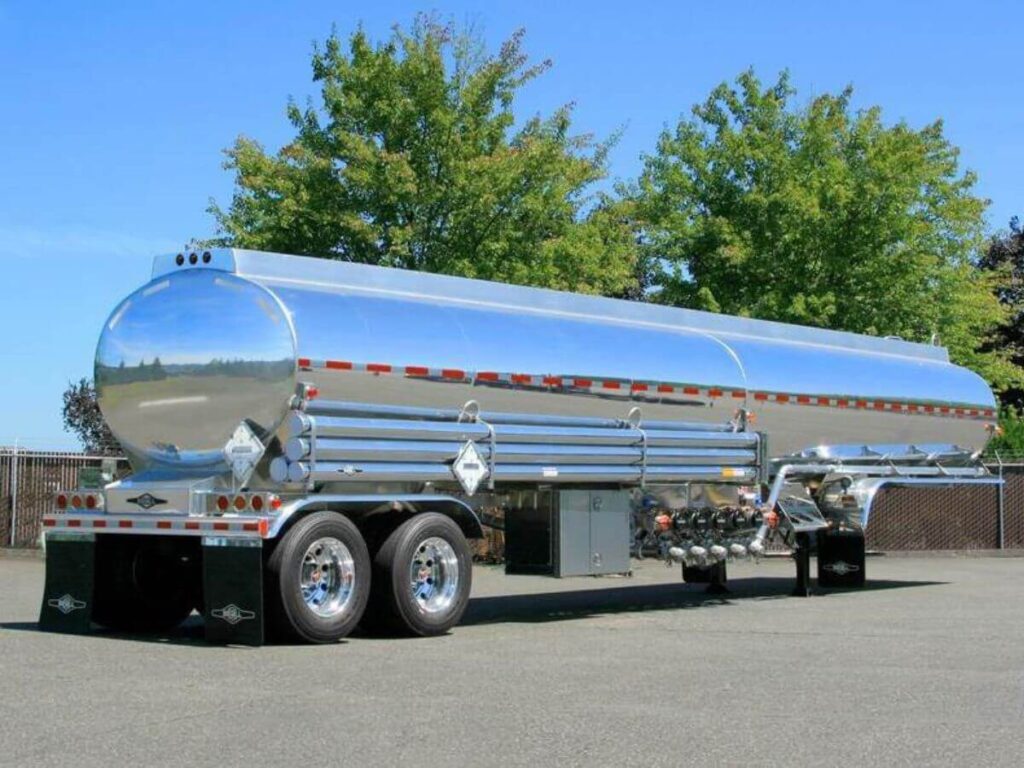
4. Structural Features and Core Components
When I first started working around tanker trailers, I didn’t realize how many parts had to work together just to move one load safely. If you’re planning to use one, here are the key features you should know:
Tank Body Shape
- Cylindrical: Most common; helps control liquid movement during transport.
- Elliptical: Lower center of gravity; offers better stability on the road.
- Conical: Sloped shape helps with unloading thicker liquids or dry bulk.
Materials
- Aluminum: Lightweight and rust-resistant; mostly used for fuel transport.
- Stainless steel: Durable and easy to clean; best for food or chemical cargo.
- Carbon steel: Heavier and more affordable; common for dry materials like cement.
Compartments
- Single-compartment: Carries one type of cargo at a time.
- Multi-compartment: Holds multiple types of liquid without mixing them; ideal for fuel delivery.
Valves and Hoses
- Bottom discharge valves: Allow fast unloading from beneath the tank.
- Manhole covers: Provide access for cleaning and inspection.
- Pressure release valves: Help release excess pressure safely, especially in gas or chemical tankers.
Insulation and Heating
- Used for temperature-sensitive cargo like edible oils or certain chemicals.
- Helps keep the product hot, cold, or stable during long hauls.
Suspension and Axles
- Chosen based on load weight and road type.
- Heavy-duty air suspension may be needed for rough roads or heavier products.
Loading Options
- Top load: Filled from above; more common in basic setups.
- Bottom load: Filled from underneath using pumps; faster and cleaner, often used in fuel delivery.
Understanding these features helps you pick the right tanker trailer for your job. Every part plays a role—whether you’re hauling milk or moving liquid asphalt.
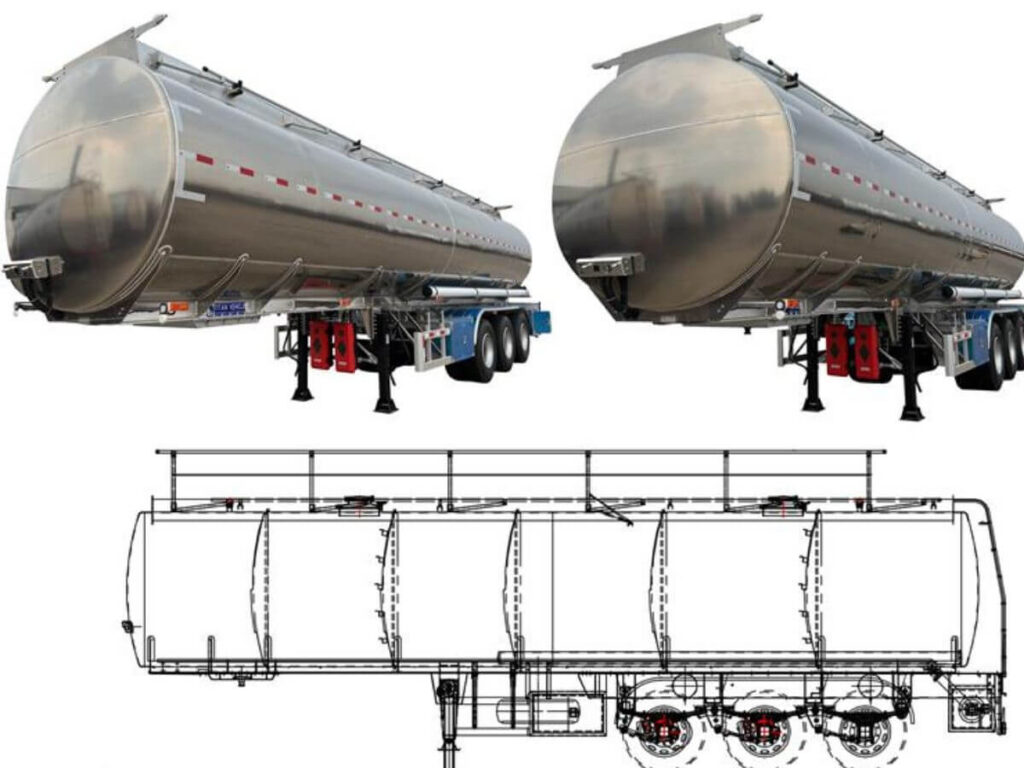
5. Key Industries That Use Tanker Trailers
A stream of water splashed across the cracked ground as a tanker rolled past, its engine humming low and steady. The air smelled like hot rubber and damp soil, and workers paused only for a second before getting back to work. If you’re trying to figure out where these trailers fit, here’s a quick look at how different industries use them.
- Construction: Tanker trailers are used to carry clean water to construction sites that lack direct access. Dry bulk tankers also move cement powder for on-site concrete mixing. In roadwork, they’re often used to control dust and spray surfaces.
- Mining: Mining sites rely on tankers to transport liquid chemicals used in processing minerals. Water tankers help control dust on gravel roads and active mining zones. These trailers are built tough to handle off-road conditions and heavy use.
- Logistics and Transportation: Tanker trailers are key for moving fuel across cities and regions. Many are used to carrying milk, juice, or cooking oil between factories and distribution centers. Some transport companies use multi-compartment designs to haul different products in one trip.
- Manufacturing: Factories use tanker trailers to bring in liquid raw materials like lubricants, solvents, or cleaning agents. These materials often require special tanks that are easy to clean and safe to use. Stainless steel tankers are a common choice for this work.
- Agriculture and Food: In farming, tankers are used to carry milk, edible oils, and liquid fertilizer. Some trailers are insulated to help keep food-grade materials fresh during transport. Others move thick liquids like molasses for animal feed.
- Oil, Gas, and Energy: This sector depends heavily on tankers to move crude oil, diesel, and LPG. These materials require careful handling and strict safety standards. Many tankers in this industry are pressurized or insulated to handle long-distance hauls.
- Retail Fuel Distribution: Fuel is delivered from terminals to gas stations using smaller tanker trailers. These trips are short but frequent, often done multiple times a day. Fast loading and unloading are important to keep fuel stations stocked.
- Independent Drivers: Many independent drivers use tanker trailers to take on high-demand contracts. Jobs vary—one week it’s water, the next it could be fuel or chemicals. A well-chosen tanker can open up steady work in different industries.

6. Tanker Trailer vs Other Trailer Types
If you’re trying to figure out whether a tanker trailer is right for your job, you’re not alone. Many people get stuck comparing trailer types—especially when they all seem to “do the job.”
But the truth is, each trailer is built for something specific. Knowing the difference can save you time, money, and frustration.
| Feature | Tanker Trailer | Flatbed Trailer | Dump Trailer | Dry Van Trailer |
| Main Cargo Type | Liquids, gases, and fine powders | Machinery, steel, building materials, pallets | Sand, gravel, soil, demolition debris | Boxed goods, furniture, electronics, dry consumer products |
| Body Design | Enclosed tank with smooth interior, sealed with valves | Open platform, no sides or roof | Box-style with hydraulic lift and rear gate | Enclosed, box-style with hard walls and rear doors |
| Loading Method | Pumped or pressurized through hoses and valves | Loaded with crane or forklift | Loaded from above or by loader | Loaded by hand or forklift through rear doors |
| Unloading Method | Through bottom or top valves, gravity, or air pressure | Removed by forklift or crane | Raised and dumped by hydraulic system | Unloaded by hand or forklift |
| Best For | Fuel, milk, edible oil, chemicals, cement powder, liquid fertilizer | Oversized items, pallets, machinery, pipes | Rock, dirt, sand, asphalt | Clothing, packaged food, appliances, consumer goods |
| Not Suited For | Pallets, boxed goods, solid cargo needing forklift | Fluids, powders, or anything needing a sealed environment | Liquids, gases, or food-grade materials | Liquids, powders, unpackaged or loose bulk cargo |
| Cleaning Needed | Requires deep cleaning, especially for food or chemical loads | No internal cleaning needed | Occasional rinse-out depending on cargo | Swept out between loads |
| Safety Concerns | High—pressurized cargo, flammable materials, slippery when unloading | Low, unless hauling heavy or unbalanced machinery | Medium—watch for load shift and tipping | Low—cargo is enclosed and stable |
| Skill Required | High—requires training in loading, unloading, pressure systems | Medium—basic loading and securing knowledge | Medium—operators must know how to dump safely | Low to medium—depending on cargo type |
| Cost Range | Higher upfront due to specialized build and safety features | Lower—more affordable and versatile | Mid-range—more expensive than flatbed but cheaper than tankers | Moderate—cheaper than tankers but higher than flatbeds |
| Who Uses It | Fuel haulers, milk distributors, chemical suppliers, agriculture, mining | Construction companies, logistics firms, equipment movers | Landscaping, mining, road crews, demolition services | Retailers, grocery suppliers, furniture stores, general transport |
7. Maintenance and Safety Guidelines for Tanker Trailers
Tanker trailers carry some of the most sensitive cargo on the road. One small leak or blocked valve can turn into a serious problem fast. That’s why good maintenance isn’t optional—it’s part of keeping your work safe, clean, and running on schedule.
Routine Tank Cleaning
If you’re hauling milk, cooking oil, or chemicals, regular cleaning is a must. Leftover residue can cause contamination, corrosion, or even chemical reactions. In most cases, you’ll need to use a certified wash station that meets FDA or industry-specific cleaning rules.
Valve and Hose Checks
Before every haul, take time to inspect the valves and hoses. These are the points where leaks often happen. Check for cracks, buildup, loose connections, or anything that looks worn.
Pressure System Maintenance
If you’re using a tanker that moves LPG, LNG, or any pressurized liquid, the pressure system must be in top shape. That includes the valves, gauges, and relief systems. Always follow the maintenance schedule for high-pressure units to avoid dangerous blowouts.
Certification Inspections
Depending on what you haul and where, you may need to meet DOT, ADR, or FDA requirements. These certifications require regular checks by approved inspectors. If your trailer isn’t up to code, you can’t legally run it.
Driver Training
Make sure anyone operating the tanker knows how to load and unload safely. This means handling pressure controls, managing weight balance, and knowing what to do in case of a spill or leak. A few hours of training can prevent serious accidents.
Corrosion Checks
Over time, chemicals and moisture can eat away at the tank walls—especially in older trailers. Inspect the tank interior and exterior for signs of rust or pitting. Stainless steel helps, but no material lasts forever without upkeep.
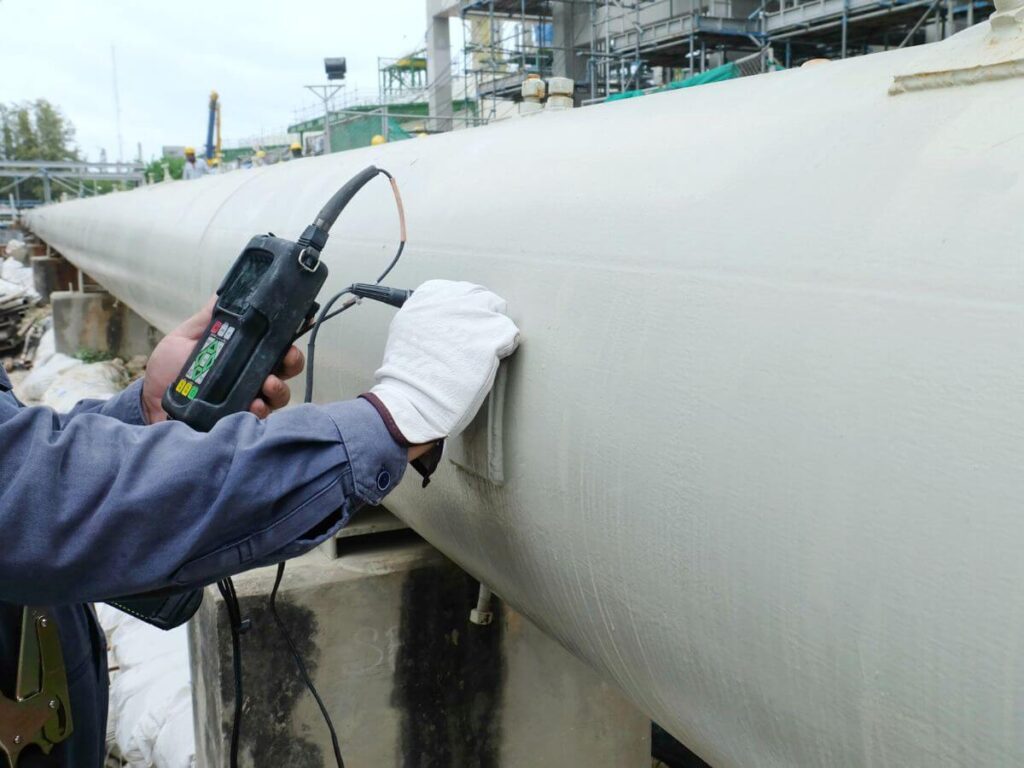
8. How to Choose the Right Tanker Trailer for Your Business
Choosing a tanker trailer can feel like a big decision, especially if it’s your first time buying one. But it doesn’t have to be complicated. The key is to match the trailer to the work you’re doing every day.
#1 Cargo Type
Every tanker is designed for a specific kind of load. Liquids, gases, and powders each need different tank structures and features. For example, edible liquids like milk require food-safe materials, while pressurized gases need special safety systems. Knowing what you’re hauling is the first step in choosing the right trailer.
#2 Right Material
The material your tank is made from affects durability, weight, and what it can safely carry. Aluminum is lightweight and works well for fuel transport. Stainless steel is stronger and better for food or chemical loads, thanks to its corrosion resistance. Carbon steel is more affordable and often used for dry bulk products like cement or flour.
#3 Required Capacity
Tanker capacity is usually listed in liters or gallons. The right size depends on how much you transport per trip and how far you’re going. If you choose a tank that’s too small, you’ll make more runs. If it’s too large, you might waste fuel or run into road restrictions.
#4 Compartments?
Multi-compartment tankers let you carry more than one product without mixing them. This is helpful for deliveries to multiple locations or customers on a single route. Fuel delivery is a common example where compartments save time. It can also cut down on return trips and boost your efficiency.
#5 Local Regulations
Local laws can limit trailer weight, axle spacing, and even what materials you’re allowed to haul. Depending on your cargo, you may need to meet DOT, ADR, or FDA certifications. These rules can vary by region, and skipping them could cause delays or legal trouble. At rhinotrail, we customize tanker trailers to meet local and international regulations, so you can haul with confidence and stay compliant wherever your business takes you.
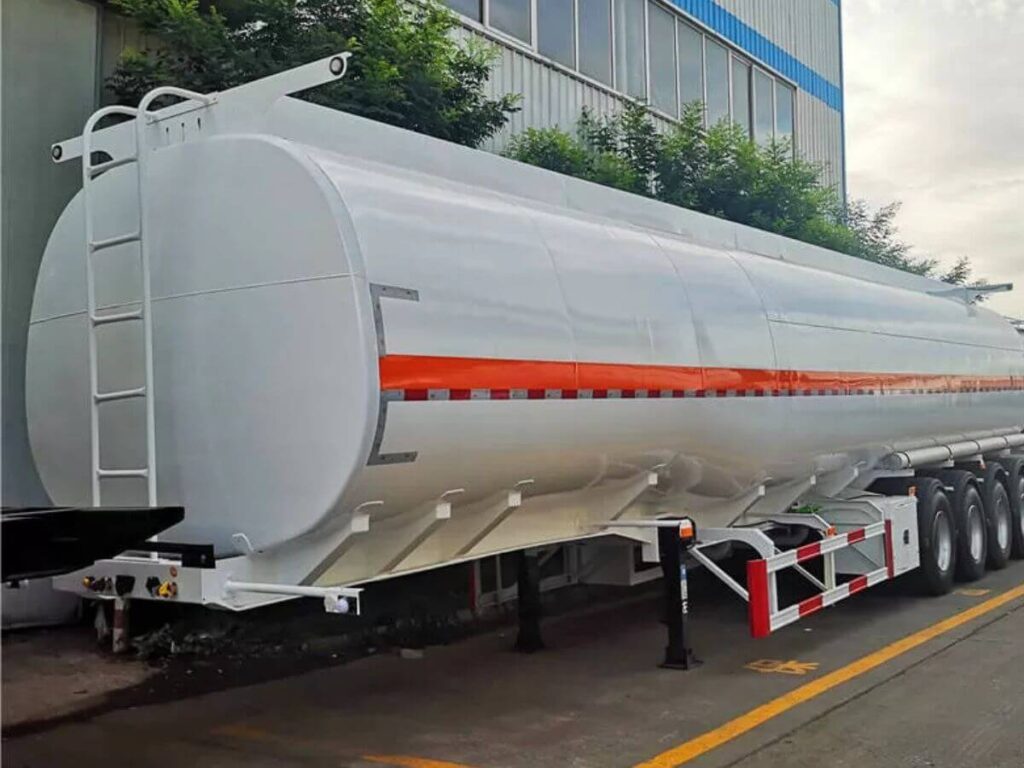
Conclusion
You’ve learned what tanker trailers carry, how they’re built, and why different industries depend on them. I’ve seen first-hand how choosing the right one can make your work safer, faster, and more reliable.
You’ve got the knowledge—now it’s time to act.
Are you ready to take the next step?
Whether it’s fuel, food, or chemicals, there’s a trailer out there that fits your job—and we can help you find it.
Contact us to get started today.


